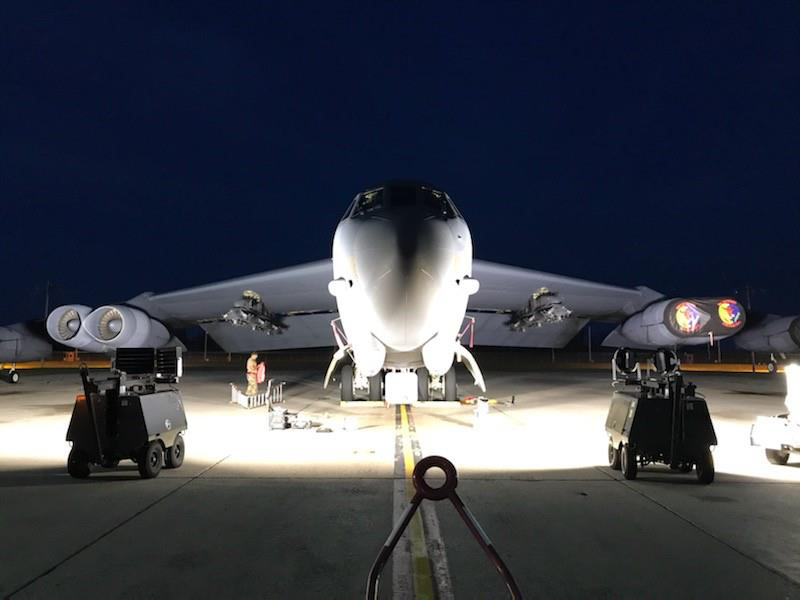How the Air Force is making it easier for aircraft maintainers to see at night
WRIGHT-PATTERSON AIR FORCE BASE, Ohio – We all know that working in the dark with insufficient lighting makes the task that much more cumbersome. Good quality lighting is critical for maintainers when repairing an aircraft on the flightline.
The U.S. Air Force has an inventory of approximately 5,500 four-wheel diesel light carts that provide flightline and perimeter illumination. This lighting is a necessity for aircraft maintenance, troubleshooting and outside lighting to secure the outskirts of deployed/contingency locations.
Recently, a cross-enterprise team from the Air Force Materiel Command, Air Force Global Strike Command, and Concurrent Technologies Corporation successfully conducted testing at Minot Air Force Base on a flightline light cart retrofit kit that contains new Light Emitting Diode (LED) fixtures.
“This activity is in direct response to a request made by AFGSC Director of Logistics and Engineering during the U.S. Air Force Basing and Logistics Senior Leader Showcase at the Materials and Manufacturing Directorate in April 2019,” said Tom Layne, Air Force Research Laboratory Advanced Power Technology Office Project Engineer. “We wanted to move out rapidly with a great team – our biggest challenge was the schedule impact from COVID.
The LED fixtures are intended to replace legacy metal-halide lamps on flightline FL-1D light carts. LEDs offer many advantages to an agile and resilient flightline, such as immediate illumination, longer life, improved color rendering and lower operating temperatures.
Testing evaluated the retro-kit conversion instructions and solicited feedback from the maintainers who use the light carts. Project funding was made possible by the Assistant Secretary of the Air Force for Energy, Installations, and Environment.
“The installation and conversion of the new LED lights was quick and easy,” said Senior Airman Matthew Brown, Minot 5th Maintenance Squadron AGE Flight, who performed the conversion.
“The instructions provided to our team were very clear cut and easy to apply. The kits had everything we needed – the process was fast and smooth. Through our tests we found only a few things that could potentially be improved. The lights are very well designed and they performed at a very high level – a level I feel the Air Force needs moving forward. I am honored to have been a part of the team selected to do the conversion,” said Brown.
“These lights are amazing,” said Master Sgt. Alvarez, the project lead from Minot 5th Maintenance Squadron AGE Flight.
“Improved LED lighting makes B-52 maintenance safer, more efficient and more effective,” said Master Sgt. Matthew Petersen, B-52 Production Superintendent at Minot AFB. “Foreign object debris/damage prevention is extremely important for the TF-33 engine sustainment to 2050. In addition to improved lighting for maintenance, it is much easier to find metal shavings, rivet stems, foreign objects and tools with this improved lighting.”
“The Minot LED test results combined with previous results, prove that future light carts acquisition specify LED lights instead of metal halide lights, and make a strong argument for the LED retrofits,” said Jeff Hill, program office engineer.
According to Chief Master Sgt. Mark Haralson, Command Aviation Support Equipment Manager, the new fixtures are being evaluated as an enterprise-wide solution to maximize commonality and standardization on the flightline.
The next step includes completing the final report in support of the Air Force Life Cycle Management Center Configuration Control Board issuing fleetwide modification approval.
For more statistics about APTO efforts, contact AFRL.RXSC.APTO@us.af.mil, or Call us at 937-904-5046.

Side by side comparison of the two Light Emitting Diode fixture options. Per Master Sgt. Petersen both LED options were improvements over the legacy metal-halide fixtures. (U.S. Air Force photo/Master Sgt. Matthew Petersen)

“Improved LED lighting makes B-52 maintenance safer, more efficient and more effective,” said Master Sgt. Matthew Petersen, B-52 Production Superintendent. (U.S. Air Force photo/Master Sgt. Matthew Peterson)

Senior Airman Matthew Brown, Minot 5th Maintenance Squadron AGE Flight, compares a legacy metal-halide lamp with a new LED fixture. (U.S. Air Force photo/Master Sgt. Miguel Alvarez)

Air Force Global Strike Command 5th Maintenance Squadron AGE Section Chief, Master Sgt. Miguel Alvarez, in front of four flightline light carts retro-fitted with the two different LED fixture options for testing. (U.S. Air Force photo/Senior Airman Matthew Brown)
